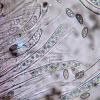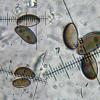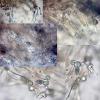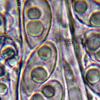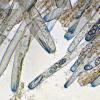
21-12-2025 21:32
Pol DebaenstHello, Garden, Burgweg 19, Veurne, BelgiumOn 10/1

22-12-2025 00:47
Patrice TANCHAUDBonsoir, récolte à proximité du milieu dunaire

21-12-2025 21:40
Isabelle CharissouBonjour, j'aimerais connaitre les références de

21-12-2025 21:31
Pol DebaenstHello, Garden, Burgweg 19, Veurne, BelgiumOn 10/1

21-12-2025 21:31
Pol DebaenstHello, Garden, Burgweg 19, Veurne, BelgiumOn 10/1

20-12-2025 23:08
Patrice TANCHAUDBonsoir, récolte sur sol sablonneux dans l'arri�

21-12-2025 09:32
Hello.A tiny ascomycete found embedded in wood in

20-12-2025 15:47
Mirek GrycHi.These grew on pine wood that was heavily covere
Asco sur les feuilles d'olivier
Pablo Chacón,
18-01-2009 21:45
 Buenas noches,
Buenas noches,Necesito alguna idea para empezar a buscar
sobre hojas de olivo
---------------------------------
Bonnes nuits,
J'ai besoin d'une certaine idée pour commencer à chercher
sur les feuilles d'olivier
Merci
Pablo Chacón
Pablo Chacón,
18-01-2009 22:25
Guy Garcia,
18-01-2009 22:31
Re:Asco sur les feuilles d'olivier
Peut-être vers le genre Lambertella ???
Pablo Chacón,
18-01-2009 22:48

Re:Asco sur les feuilles d'olivier
Bonnes nuits Guy,
Où peux-je trouver une information sur ce type ? classe Lambertella.
Où peux-je trouver une information sur ce type ? classe Lambertella.
Guy Garcia,
18-01-2009 23:31
Re:Asco sur les feuilles d'olivier
Salut Pablo,
Ce qui me fait penser au genre Lambertella c'est les spores colorées à maturité, mais je n'ai jamais étudié d'espèce de ce genre !
Je n'ai pas de littérature sous la main, mais regardes
DUMONT K.P. 1971 Sclerotiniaceae II. Lambertella Mem. New York Bot. Gard. 22 1 1-178.
Voir aussi
GALÁN R. & PRIETO F. 2004 Lambertella palmeri Raitv. & R.Galán descubierta en el continente europeo. [photos]. Bol. Soc. Micol. Madrid 28 161-167. mais les spores sont bien différentes et le support est sur feuille de Quercus.
Amitiés, Guy
Ce qui me fait penser au genre Lambertella c'est les spores colorées à maturité, mais je n'ai jamais étudié d'espèce de ce genre !
Je n'ai pas de littérature sous la main, mais regardes
DUMONT K.P. 1971 Sclerotiniaceae II. Lambertella Mem. New York Bot. Gard. 22 1 1-178.
Voir aussi
GALÁN R. & PRIETO F. 2004 Lambertella palmeri Raitv. & R.Galán descubierta en el continente europeo. [photos]. Bol. Soc. Micol. Madrid 28 161-167. mais les spores sont bien différentes et le support est sur feuille de Quercus.
Amitiés, Guy
Pablo Chacón,
18-01-2009 23:45

Re:Asco sur les feuilles d'olivier
Je n'ai pas ces travaux.
une salutation
Pablo
une salutation
Pablo
Hans-Otto Baral,
18-01-2009 23:48

Re:Asco sur les feuilles d'olivier
I also think this is a Lambertella, very interesting! There is a synoptic key to the species in
Korf & Zhuang, Mycotaxon 24: 361-386 (1985)
I can try, but tomorrow.
It seems that the spores are ejected hyaline and get brown and small-guttulate only when overmature.
Lambertella has prismatic, elongated cells in the excipulum, similar as Rutstroemia.
zotto
Korf & Zhuang, Mycotaxon 24: 361-386 (1985)
I can try, but tomorrow.
It seems that the spores are ejected hyaline and get brown and small-guttulate only when overmature.
Lambertella has prismatic, elongated cells in the excipulum, similar as Rutstroemia.
zotto
Pablo Chacón,
19-01-2009 00:00

Re:Asco sur les feuilles d'olivier
Thanks Otto,
Tomorrow I will try a microscopy of the excipulum
¿That you think of the incrustations of hifas?
Pablo
Tomorrow I will try a microscopy of the excipulum
¿That you think of the incrustations of hifas?
Pablo
NC NC,
19-01-2009 03:20
Re:Asco sur les feuilles d'olivier
I, too, think this is surely a Lambertella. The synoptic key can be retrieved from that volume of Mycotaxon, online from CYBERLIBER (see link on main page of Mycotaxon, www.mycotaxon.com>. Dick Korf
Hans-Otto Baral,
19-01-2009 15:42

Re:Asco sur les feuilles d'olivier
The "incrustations" appear to be crystals, presumably of calcium oxalate, a not rare feature of sclerotiniaceous fungi.
Zottto
Zottto
François Valade,
19-01-2009 18:57

Re:Asco sur les feuilles d'olivier
Pablo
tu peux aussi consulter le site consacré aux espèces nordiques de ce groupe d'inoperculés. L'Espagne est certes assez éloignée de la Norvège mais c'est riche en informations.
http://biologi.uio.no/bot/ascomycetes/Taxa/Lambertella.html
François
tu peux aussi consulter le site consacré aux espèces nordiques de ce groupe d'inoperculés. L'Espagne est certes assez éloignée de la Norvège mais c'est riche en informations.
http://biologi.uio.no/bot/ascomycetes/Taxa/Lambertella.html
François
Pablo Chacón,
19-01-2009 19:32

Re:Asco sur les feuilles d'olivier
Merci François,
Si, je connais cette page.
Salutacions
Si, je connais cette page.
Salutacions
Pablo Chacón,
21-01-2009 11:17

Re:Asco sur les feuilles d'olivier
Bonjour,
S'il vous plaît., Serais très reconnaissant si quelqu'un m'envoie documentation Lambertella de continuer à étudier cette espèce.
Merci
Pablo
S'il vous plaît., Serais très reconnaissant si quelqu'un m'envoie documentation Lambertella de continuer à étudier cette espèce.
Merci
Pablo
René Dougoud,
21-01-2009 14:17
Re:Asco sur les feuilles d'olivier
Bien Cher Collègue,
Je dispose de la monographie du genre Lambertella par Dumont (1971), 176 pages !
Je peux, dans un premier temps, t'envoyer la clé que je veux scanner. Puis dans un deuxième temps, la ou les descriptions pouvant correspondre à ta récolte. Tu me demanderas ce que tu souhaites !
René
Je dispose de la monographie du genre Lambertella par Dumont (1971), 176 pages !
Je peux, dans un premier temps, t'envoyer la clé que je veux scanner. Puis dans un deuxième temps, la ou les descriptions pouvant correspondre à ta récolte. Tu me demanderas ce que tu souhaites !
René
Pablo Chacón,
21-01-2009 16:09

Re:Asco sur les feuilles d'olivier
Merci René,
s'il vous plaît, envois la clé pour voir si je peux identifier ma récolte.
Merci beaucoup
Pablo Chacón
s'il vous plaît, envois la clé pour voir si je peux identifier ma récolte.
Merci beaucoup
Pablo Chacón
Pablo Chacón,
24-01-2009 18:59

Re:Asco sur les feuilles d'olivier
salut à à tous
Merci à la clé de René Dougoud, je retourne à l'espèce qui nous concerne, je décris les nouvelles espèces.
Des exemplaires de 2 à 3 mm, avec himenio sombre, partie extérieure du ascoma blanc. avec petit stipite.
Asques de 120-140 microns rarement 150 microns. Mezler negative
Ascospores unisériées ou biseriate de 11-15 microns, avec deux o trois gutules,majoritairement deux. Brunne dans la maturité, presqu'en perdant les gutulas qui se logent dans les pôles.
Paráfisis Cloisonnées même taille que asques.
Excipum, je pense que prismatique, joint photo, pour moi aider, je n'observe pas bien.
On observe des cheveux dans la partie extérieure d'ascoma, mais au microscope on n'observe rien.
Avec la clé de Lambertella, je pense L.brunneola? (sans aucune conviction) peut-être, bien que les tailles (selon la clé, 13-14,5microns X 4-5microns) ne soient pas correctes. Il existe seulement trois espèces J- c'est pourquoi je pense qu'il peut être de de celle-ci, puisque les autres deux, paraissent moins.?????
Merci, Grâce à tous.
Pablo Chacón
Merci à la clé de René Dougoud, je retourne à l'espèce qui nous concerne, je décris les nouvelles espèces.
Des exemplaires de 2 à 3 mm, avec himenio sombre, partie extérieure du ascoma blanc. avec petit stipite.
Asques de 120-140 microns rarement 150 microns. Mezler negative
Ascospores unisériées ou biseriate de 11-15 microns, avec deux o trois gutules,majoritairement deux. Brunne dans la maturité, presqu'en perdant les gutulas qui se logent dans les pôles.
Paráfisis Cloisonnées même taille que asques.
Excipum, je pense que prismatique, joint photo, pour moi aider, je n'observe pas bien.
On observe des cheveux dans la partie extérieure d'ascoma, mais au microscope on n'observe rien.
Avec la clé de Lambertella, je pense L.brunneola? (sans aucune conviction) peut-être, bien que les tailles (selon la clé, 13-14,5microns X 4-5microns) ne soient pas correctes. Il existe seulement trois espèces J- c'est pourquoi je pense qu'il peut être de de celle-ci, puisque les autres deux, paraissent moins.?????
Merci, Grâce à tous.
Pablo Chacón
Hans-Otto Baral,
24-01-2009 20:09

Re:Asco sur les feuilles d'olivier
Dear Pablo
it is really a very difficult genus in which I have little experience. I was astonished that you did not see an iodine reaction, but in the above synoptic key I see that many are said to be inamyloid (I hope these data derive from tests with KOH-pretreatment).
There are a lot of species on leaves in this key, but Olea does not occur. I can only recommend to test this key to see which further characteristics are relevant.
Please go to
http://www.cybertruffle.org.uk/cyberliber/
click journals on the left, go to Mycotaxon, enter journal number 24 and go to
pp. 373-383
good luck!
Zotto
it is really a very difficult genus in which I have little experience. I was astonished that you did not see an iodine reaction, but in the above synoptic key I see that many are said to be inamyloid (I hope these data derive from tests with KOH-pretreatment).
There are a lot of species on leaves in this key, but Olea does not occur. I can only recommend to test this key to see which further characteristics are relevant.
Please go to
http://www.cybertruffle.org.uk/cyberliber/
click journals on the left, go to Mycotaxon, enter journal number 24 and go to
pp. 373-383
good luck!
Zotto
Pablo Chacón,
24-01-2009 20:55

Re:Asco sur les feuilles d'olivier
Dear Zotto¡,
Very difficult, to decipher the page that you recommend to me, !!uff¡¡
Now I do not have KOH, if NAOH, it ¿serves? it did not know that there was to make a previous processing (because ) please you can explain to me.
Is very difficult and very interesting, a rare species.
Thanks Zotto
Pablo
Very difficult, to decipher the page that you recommend to me, !!uff¡¡
Now I do not have KOH, if NAOH, it ¿serves? it did not know that there was to make a previous processing (because ) please you can explain to me.
Is very difficult and very interesting, a rare species.
Thanks Zotto
Pablo
Hans-Otto Baral,
24-01-2009 22:03

Re:Asco sur les feuilles d'olivier
yes, the collection is really interesting.
NaOH does the same, but should be at least 1-2%. If you use Lugol you must not pretreat.
I do not expect a hemiamyloid ring here but who knows.
Zotto
NaOH does the same, but should be at least 1-2%. If you use Lugol you must not pretreat.
I do not expect a hemiamyloid ring here but who knows.
Zotto
Pablo Chacón,
24-01-2009 23:05
Hans-Otto Baral,
24-01-2009 23:20

Re:Asco sur les feuilles d'olivier
Hui, thanks, that doesn't look negative. Not clearly blue but I would say faintly positive (grey-blue). I assume you do not see the ring unless you add iodine?
Zotto
Zotto
Pablo Chacón,
25-01-2009 00:19

Re:Asco sur les feuilles d'olivier
Now I see the ring, thanks.
I am not safe, tomorrow I will realise another test, but I believe that not hemiamyloid iodine, I have not seen anything with Betadine and to mezler
Pablo
I am not safe, tomorrow I will realise another test, but I believe that not hemiamyloid iodine, I have not seen anything with Betadine and to mezler
Pablo
Hans-Otto Baral,
25-01-2009 12:10

Re:Asco sur les feuilles d'olivier
What is betadine? What you can do is mount a fragment in your NaOH for some minutes, dilute the preparation a bit with water, and then add Lugol or Melzer. perhaps the rings get more distinctly blue then.
This is a good example that a pure distinction between J+ and J-, as done in the synoptic key to Lambertella, is not enough. Your species can easily be taken as J-, but is obviously J+, though only weakly so.
Zotto
This is a good example that a pure distinction between J+ and J-, as done in the synoptic key to Lambertella, is not enough. Your species can easily be taken as J-, but is obviously J+, though only weakly so.
Zotto
François Valade,
25-01-2009 12:24

Re:Asco sur les feuilles d'olivier
Zotto
Betadine is iodine solution (10% of iodic povidone and many excipients) for skin. It is used in surgery and can also be bought at chemist's.
François
Betadine is iodine solution (10% of iodic povidone and many excipients) for skin. It is used in surgery and can also be bought at chemist's.
François
Pablo Chacón,
25-01-2009 12:29

Re:Asco sur les feuilles d'olivier
Betadine: povidona or polividona iodized to products realised on the basis of a solution of povidona and molecular iodine, in a 10%. to put generally in wounds.
commercial product, gives to very positive results in pezizales and some helotiales.
Pablo
commercial product, gives to very positive results in pezizales and some helotiales.
Pablo
Hans-Otto Baral,
25-01-2009 18:34

Re:Asco sur les feuilles d'olivier
o.k., thanks, interesting. I did not now the name Betadine. Some decades ago we used for wounds tincture of iodine which is alcoholic (see below).
In Wiki I see that :
Povidone-iodine (PVPI) is a water-soluble complex of iodine with polyvinylpyrrolidone
(PVP), with from 9.0% to 12.0% available iodine, calculated on a dry basis
So it has about 1 % iodine similar as Lugol or Melzer.
It would be interesting to find out whether or not this suppresses the red hemiamyloid reaction similar as Melzer.
Tincture of iodine in English Wikipedia is said to contain usually 2-7% potassium iodide or sodium iodide in ethanol. I think this is an error, they forgot the iodine. Elsewhere I see that it is I2, KI, water and 90% alcohol.
Zotto
In Wiki I see that :
Povidone-iodine (PVPI) is a water-soluble complex of iodine with polyvinylpyrrolidone
(PVP), with from 9.0% to 12.0% available iodine, calculated on a dry basis
So it has about 1 % iodine similar as Lugol or Melzer.
It would be interesting to find out whether or not this suppresses the red hemiamyloid reaction similar as Melzer.
Tincture of iodine in English Wikipedia is said to contain usually 2-7% potassium iodide or sodium iodide in ethanol. I think this is an error, they forgot the iodine. Elsewhere I see that it is I2, KI, water and 90% alcohol.
Zotto
Pablo Chacón,
25-01-2009 19:04

Re:Asco sur les feuilles d'olivier
Dear Zotto.
I have made the reaction with the NaOH, and believe that I see better the ring,but I am not safe; the problem is that the microscope has spoiled me and I cannot teach to no photo.
¡¡¡ I hope to solve it fast !! : o (
Attached photo amiloidad of pezizal with “Betadine” is seen very well.
Pablo
I have made the reaction with the NaOH, and believe that I see better the ring,but I am not safe; the problem is that the microscope has spoiled me and I cannot teach to no photo.
¡¡¡ I hope to solve it fast !! : o (
Attached photo amiloidad of pezizal with “Betadine” is seen very well.
Pablo
Hans-Otto Baral,
30-01-2009 18:14

Re:Asco sur les feuilles d'olivier
Today I looked at the dried material. Regrettably the asci are evanescent in this species, while the brown spores are still in situ in masses in the hymenium. My test of the synoptic key led to a surprize: I confirm Pablo that there are numerous crystals in the medulla. There are, however, only three species listed which have crystals (either in the stipe or the hymenium). None of them come in consideration (nr. 12 has 4-spored asci, nr. 16 much smaller spores, nr. 47 grows on branches, and both 16 and 47 have a puncate spore wall). So the species seems indeterminable, I attach some images. It is interesting that the brown spores are strongly inequilateral, remaining hyaline and more thin-walled at one face which collapses in KOH. I did not find this character in the key, although I know this also in a collection tentatively identified as L. corni-maris by Terry Palmer. This find is actually similar to that on Olea but the spoeres are smaller and distinctly punctate.
Zotto
I found the spores completely smooth
Zotto
I found the spores completely smooth
Hans-Otto Baral,
30-01-2009 18:16
Hans-Otto Baral,
30-01-2009 18:18
Guy Garcia,
30-01-2009 22:24
Re:Asco sur les feuilles d'olivier
Hi Zotto,
Depuis la clé synoptique de Korf & Zhuang (1985) il a été publié ou transféré 20 espèces dans le genre Lambertella !
Lors de la publication de Lambertella caudatoides, Zhuang (1999) signale des spores dont la paroi est irrégulièrement colorée, caractère accentué surtout dans le bleu cotton.
Pour la récolte de Palmer voir peut-être vers Lambertella verrucosispora W.Y. Zhuang 1990 Mycotaxon 39 : 483.
J'ai consulté pas mal de littérature sur le genre Lambertella et je n'ai rien trouvé de décrit sur feuilles d'olivier.
Reste à Pablo de retrouver cette espèce ! De mon côté, je fouillerai les feuilles d'olivier, support sur lequel très peu d'asco ont été décrit !
Amitiés, Guy
Depuis la clé synoptique de Korf & Zhuang (1985) il a été publié ou transféré 20 espèces dans le genre Lambertella !
Lors de la publication de Lambertella caudatoides, Zhuang (1999) signale des spores dont la paroi est irrégulièrement colorée, caractère accentué surtout dans le bleu cotton.
Pour la récolte de Palmer voir peut-être vers Lambertella verrucosispora W.Y. Zhuang 1990 Mycotaxon 39 : 483.
J'ai consulté pas mal de littérature sur le genre Lambertella et je n'ai rien trouvé de décrit sur feuilles d'olivier.
Reste à Pablo de retrouver cette espèce ! De mon côté, je fouillerai les feuilles d'olivier, support sur lequel très peu d'asco ont été décrit !
Amitiés, Guy
Hans-Otto Baral,
31-01-2009 11:21

Re:Asco sur les feuilles d'olivier
Dear Guy
you are right, there happened a lot since 1985. But I am convinced that some of the species placed in such sclerotiniaceous genera like Lambertella, Lanzia and Torrendiella are in fact species of Hymenoscyphus or of a closely related genus. I mention that since several decades and draw attention to the value of the apical ring of the Sclerotinia vs. Hymenoscyphus type. For ex., Lambertella caudatoides is surely a Hymenoscyphus, judging from the description. Pablo's collection is sclerotiniaceous without doubt, what can be seen, e.g., from the shape of the apical ring.
Whether this species is restricted to Olea leaves or has a much wider host spectrum is still very unclear to me.
Amitiés
Zotto
you are right, there happened a lot since 1985. But I am convinced that some of the species placed in such sclerotiniaceous genera like Lambertella, Lanzia and Torrendiella are in fact species of Hymenoscyphus or of a closely related genus. I mention that since several decades and draw attention to the value of the apical ring of the Sclerotinia vs. Hymenoscyphus type. For ex., Lambertella caudatoides is surely a Hymenoscyphus, judging from the description. Pablo's collection is sclerotiniaceous without doubt, what can be seen, e.g., from the shape of the apical ring.
Whether this species is restricted to Olea leaves or has a much wider host spectrum is still very unclear to me.
Amitiés
Zotto
NC NC,
01-02-2009 18:43
Re:Asco sur les feuilles d'olivier
Good afternoon, Zotto and Guy.
I am glad that the sample has arrived well.
I observe, the crystals in medullary excipulum, as I saw.OK.
It seems that we are before a very interesting and rare species, that to motivate to me much more to leave to find it again, by Valencia it rains right now, I believe that will return to appear soon.
¿?...Now that :o)
Pablo
Zotto, what data you want of this collection?
I am glad that the sample has arrived well.
I observe, the crystals in medullary excipulum, as I saw.OK.
It seems that we are before a very interesting and rare species, that to motivate to me much more to leave to find it again, by Valencia it rains right now, I believe that will return to appear soon.
¿?...Now that :o)
Pablo
Zotto, what data you want of this collection?
Pablo Chacón,
01-02-2009 18:50

Re:Asco sur les feuilles d'olivier
Good afternoon Zotto and Guy.
I am glad to see that the good sample arrived
I observe, the crystals in medullary excipulum, as I saw.
It seems that we are before a very interesting and rare species, that to motivate to me much more to leave to find it again, by Valencia it rains right now, I believe that will return to appear soon.
¿?... Now that? :o)
Zotto, what data you want of the collection?
Pablo
I am glad to see that the good sample arrived
I observe, the crystals in medullary excipulum, as I saw.
It seems that we are before a very interesting and rare species, that to motivate to me much more to leave to find it again, by Valencia it rains right now, I believe that will return to appear soon.
¿?... Now that? :o)
Zotto, what data you want of the collection?
Pablo
Hans-Otto Baral,
01-02-2009 21:05

Re:Asco sur les feuilles d'olivier
For my database I need
-collection date (day, month)
-site name, village, next town, county
-collector
-if possible altitude above sea level
thanks!
zotto
-collection date (day, month)
-site name, village, next town, county
-collector
-if possible altitude above sea level
thanks!
zotto



